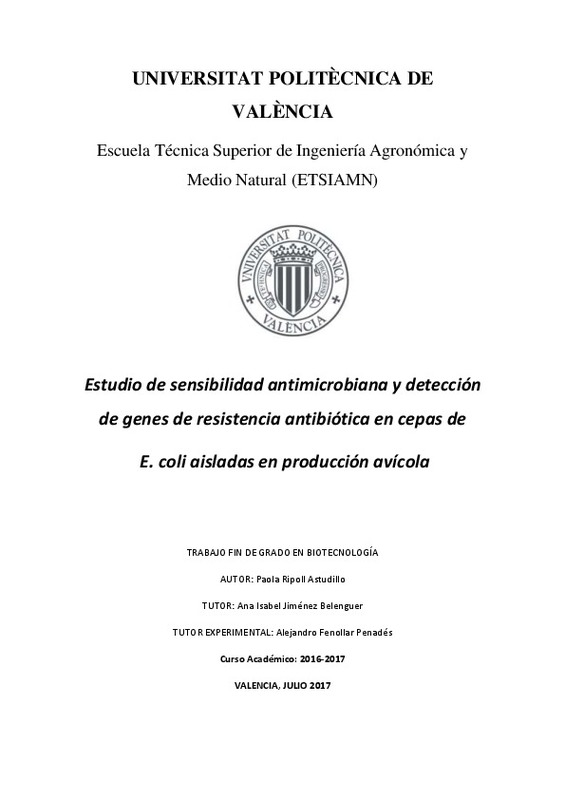JavaScript is disabled for your browser. Some features of this site may not work without it.
Buscar en RiuNet
Listar
Mi cuenta
Estadísticas
Ayuda RiuNet
Admin. UPV
Estudio de sensibilidad antimicrobiana y detección de genes de resistencia antibiótica en cepas de E. coli aisladas en producción avícola
Mostrar el registro sencillo del ítem
Ficheros en el ítem
| dc.contributor.advisor | Jiménez Belenguer, Ana Isabel
|
es_ES |
| dc.contributor.advisor | Fenollar Penadés, Alejandro
|
es_ES |
| dc.contributor.author | Ripoll Astudillo, Paola
|
es_ES |
| dc.date.accessioned | 2017-09-08T07:08:00Z | |
| dc.date.available | 2017-09-08T07:08:00Z | |
| dc.date.created | 2017-07-21 | |
| dc.date.issued | 2017-09-08 | es_ES |
| dc.identifier.uri | http://hdl.handle.net/10251/86773 | |
| dc.description.abstract | [ES] En las últimas décadas se ha incrementado la preocupación del público por el uso que se hace de los antibióticos debido a la aparición de cepas resistentes que se han propagado y que han ido limitando en algunos casos la efectividad de los antibióticos para tratar infecciones bacterianas en humanos. El tracto gastrointestinal humano es un reservorio importante de bacterias con capacidad tanto de recibir como de transferir genes de resistencia, por lo que es importante tener en cuenta el fenómeno de la transmisión genética horizontal como un riesgo añadido ya que si los alimentos ingeridos están contaminados con cepas bacterianas resistentes éstas pueden llegar al consumidor. En el presente trabajo se estudiaron 191 cepas de E. coli procedentes de gallinas reproductoras, con el objetivo de analizar por un lado la susceptibilidad a 8 antimicrobianos distintos mediante la técnica disco-placa, y por otro la detección de genes de resistencia a antibióticos, como son: TEM, SHV, CMY-2, qnrS y ermB. Los resultados mostraron que el 84,34% de las cepas eran resistentes a al menos uno de los antibióticos y el 18,85% multirresistentes. Los antibióticos para los que más resistencias aparecieron fueron: ampicilina, ácido nalidíxico y tetraciclina, y de los 9 patrones encontrados, NA-AMP-C y NA-AMP-TE fueron los más prevalentes. En el análisis de los genes de resistencia, el gen TEM, seguido del gen qnrS fueron los que se detectaron en mayor número de cepas y estos resultados coincidieron con los antibióticos para los que aparecieron más resistencias. Finalmente, el estudio de resistencias a antibióticos y la utilización de métodos moleculares de detección de genes de resistencia resultó ser una herramienta eficaz para la caracterización de resistencias antimicrobianas. | es_ES |
| dc.description.abstract | [EN] In recent years, there has increased public concern about the use of antibiotics due to the emergence of resistant strains that have been spread and it has been restricting in some cases the effectiveness of antibiotics to treat bacterial infections in humans. The human gastrointestinal tract is an important reservoir of bacteria capable of both receiving and transferring resistance genes, it is important to consider the phenomenon of horizontal genetic transmission as an added risk because the food ingested could be contaminated with resistant bacterial strains. In this work, 191 strains of E. coli from breeding hens were studied, with the aim of analyzing the susceptibility to 8 different antimicrobials using the disk-plaque technique and, on the other, the detection of antibiotic resistance genes: TEM , SHV, CMY-2, qnrS and ermB. The results showed that 84.34% of the strains were resistant to at least one antibiotic and 18.85% multiresistant. The antibiotics that showed the greatest resistance were: ampicillin, nalidixic acid and tetracycline, and 9 patterns were found, NA-AMP-C and NA-AMPTE were the most prevalent. Analysis of the resistance genes showed that the TEM gene followed by the qnrS gene were detected in higher numbers of strains. These results were in agreement with the antibiotics more prevalent. Finally, the study of antibiotic resistance and the use of molecular methods to detect resistance genes proved to be an effective tool for the characterization of antimicrobial resistance. | es_ES |
| dc.format.extent | 46 | es_ES |
| dc.language | Español | es_ES |
| dc.publisher | Universitat Politècnica de València | es_ES |
| dc.rights | Reserva de todos los derechos | es_ES |
| dc.subject | Gallinas reproductoras | es_ES |
| dc.subject | resitencias antimicrobianas | es_ES |
| dc.subject | genes de resistencia | es_ES |
| dc.subject | transmisión E coli | es_ES |
| dc.subject | Breeding hens | es_ES |
| dc.subject | Antimicrobial resistance | es_ES |
| dc.subject | Resistance genes | es_ES |
| dc.subject | E. coli transmission | es_ES |
| dc.subject.classification | MICROBIOLOGIA | es_ES |
| dc.subject.other | Grado en Biotecnología-Grau en Biotecnologia | es_ES |
| dc.title | Estudio de sensibilidad antimicrobiana y detección de genes de resistencia antibiótica en cepas de E. coli aisladas en producción avícola | es_ES |
| dc.type | Proyecto/Trabajo fin de carrera/grado | es_ES |
| dc.rights.accessRights | Abierto | es_ES |
| dc.contributor.affiliation | Universitat Politècnica de València. Escuela Técnica Superior de Ingeniería Agronómica y del Medio Natural - Escola Tècnica Superior d'Enginyeria Agronòmica i del Medi Natural | es_ES |
| dc.contributor.affiliation | Universitat Politècnica de València. Departamento de Biotecnología - Departament de Biotecnologia | es_ES |
| dc.description.bibliographicCitation | Ripoll Astudillo, P. (2017). Estudio de sensibilidad antimicrobiana y detección de genes de resistencia antibiótica en cepas de E. coli aisladas en producción avícola. http://hdl.handle.net/10251/86773. | es_ES |
| dc.description.accrualMethod | TFGM | es_ES |
| dc.relation.pasarela | TFGM\66650 | es_ES |
Este ítem aparece en la(s) siguiente(s) colección(ones)
-
ETSIAMN - Trabajos académicos [3543]
Escuela Técnica Superior de Ingeniería Agronómica y del Medio Natural






